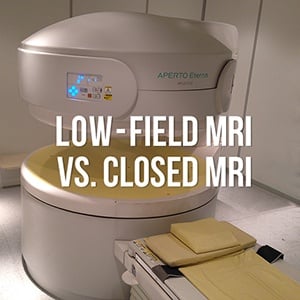
Under-powered, under-utilized, and sometimes misunderstood, open MRI systems are often under-appreciated here in the USA and ignored in other “developed” countries.
Many radiologists don’t want to read from open MRIs, governments and insurers don’t want to pay for them, and the appetite for higher and higher powered magnets has, in many cases, relegated the open MRI to a “back-up” role in larger imaging facilities.
Whether or not that relegation is deserved, it’s a fact that the demand for low-field open MRI (.2T - .35T) has remained strong in developing countries since this article was last updated in early 2016.
So what exactly is it that makes some facilities prize low-field open MRI over closed MRI?
We've found a few reasons we'll share here.
No power? No helium? No problem!
Though there are exceptions, most low-field opens (LFOs) use permanent magnets, which means that they are always “at field”.
While this might necessitate a few more transportation precautions (make sure you work with a company that knows what they’re doing), it’s a major selling point for countries where power isn’t so clean and liquid helium (used in higher-field MRIs) isn’t readily available or is extremely expensive.
Once installed, these systems tend to have very low maintenance costs relative to higher-field MRI and, if properly cared for, can run for years.
If you’re not in deep tissue, it may not be an issue
Don’t forget that, in many instances (even in the U.S.) open MRI is more than adequate for imaging needs.
In addition to being invaluable as a solution for larger or claustrophobic patients, many studies (orthopedics in particular) can be adequately performed with an open MRI.
In addition, newer versions from Hitachi like the Airis Elite and Aperto are capable of “true” fat saturation. Still, it is outside the USA that most of the current demand for low-field open MRIs exists.
Care and handling of a permanent magnet
It goes without saying that in this age of wider bores and higher Tesla strength, low-field open MRIs are almost solely a product dealt with in the secondary market.
If you have one to sell, or if you’re in the market to buy, make sure you’re dealing with a company that is used to working with these units. Even though you’re not dealing with cryogens and potential quenching, exit pathways, containers, crating, and craning can ALL be expensive and complicated.
“Always at field” means just that – and it also means they are typically very heavy.
If you are outsourcing, be sure to share any issues that might arise with the exit pathway. This is always an issue with MRI systems, but it is especially an issue with open MRIs due to the weight involved.
Buying and selling an open MRI
Just because these systems are older and often being replaced in the hospitals of developed countries by newer short/wide bore MRIs doesn’t mean they don’t have value somewhere in the world, and it doesn’t mean they aren't the right option if you’re buying and want to keep your equipment, maintenance, and energy costs low.
So- do you have (or are you looking for) a Hitachi Airis II? A Siemens Concerto or Magnetom C? A GE Profile or Ovation?
If you have one of these open MRI machines and are considering replacing it, you can contact us for a quick evaluation of your system and for any other imaging equipment needs.

Steve Rentz
Steve Rentz is the Product Manager for MRI Scanners at Block Imaging. Steve's goal is to earn each customer's trust and business by specifically addressing the needs of their unique project. When Steve is not helping customers with their MRI needs, he enjoys running, swimming, and woodworking.






